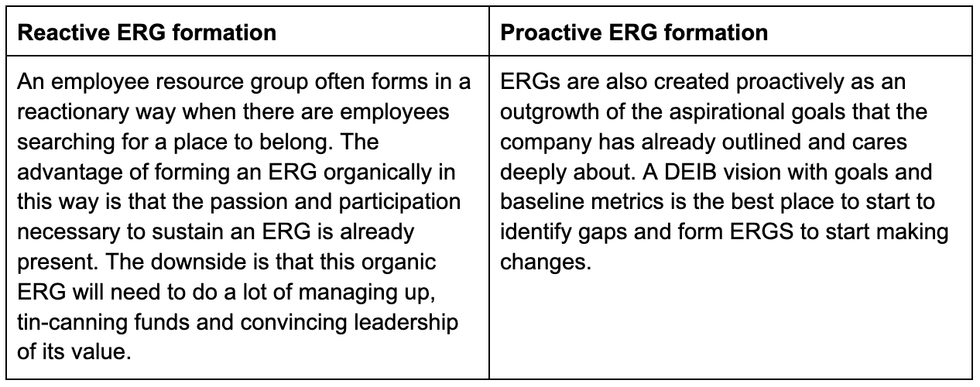An employee resource group (ERG) is an employee-led group within an organization that’s formed around a particular community or identity. For example, you may see ERGs for women, Asian-Americans, LGBTQIA+ folks, and more. When done right, ERGs are an important vehicle to drive inclusion and real belonging within the workplace.
For both your company and your employees, ERGs can be critical support structures for individuals that identify as a member of historically underrepresented groups. Diversity, equity, inclusion, and belonging (DEIB) professionals within an organization can facilitate the creation of employee resource groups and take cues from past experience to avoid pitfalls. Following best practices will help you overcome common challenges, too, such as sustainability. Let’s address all of this by taking you through the ins & outs of ERGs, including how to start and how to leverage one.
The history of Employee Resource Groups
The employee resource group has become a popular organizational feature in the last 10 years, but ERGs aren’t new. The earliest ERGs formed in the 1960s amidst rising racial tensions and widespread civil rights discussion in the United States. Often cited as the first in U.S. history, the National Black Employees Caucus at Xerox was created in 1974. Since then, employee resource groups have become a common part of a company’s overall DEIB efforts. Some 90% of Fortune 500 companies have ERGs today.
ERGs vs Affinity groups vs BRGs
An employee resource group is not the only kind of internal employee-led group.
Affinity groups are another type of employee-driven internal group. Affinity groups can also be formed around a community or identity. They typically encompass activities and interests, such cycling or zero-waste environmentalism. In traditional contexts, the term was used interchangeably with “employee resource group,” but the purpose of an affinity group is not always DEIB-related. Thus, the term ERG is now more common for groups specifically grounded in a company’s DEIB efforts to support underrepresented communities and employee identities.
Business Resource Groups are also employee volunteer-led organizations that foster DEIB within the workplace. BRGs focus specifically on employee growth via career development, networking, and mentoring. This is a more specific focus that may be part of an employee resource group, but ERGs tend to focus on wider issues beyond business growth exclusively.
What does an employee resource group do?
Many ERGs form organically, from similar people within an organization seeking support and connection. Because of that, employee resource group roles and responsibilities, scope, and function are sometimes undefined – at least initially. The function of ERGs within the organization is open to endless possibility and often evolves over time to address the most pressing issue at hand.
An employee resource group can stick with one focus area or expand to many. It’s up to their goals, resources, and HR team’s strategic vision for the various ERGs that form.
Employee Resource Group activities
1. Working with HR.
ERGs can work directly with HR to implement specific and targeted DEIB initiatives for the company. These could be:
- Helping HR diversify recruitment
- Making new hires from diverse backgrounds feel welcome
- Integrating ERG programming into the onboarding process. For example, including pronouns on all company documents/signatures/profiles from applications onwards.
2. Creating dialogue between leadership and employees.
ERGs help open up conversations for employees to talk about what they’re going through. They can serve as an important bridge between leadership and employees to communicate both ways.
ERGs should strive to be safe spaces where employees can say how they’re doing and what they need. They’re an opportunity for company leadership to listen and give employees space to do what they need – and for leadership from diverse backgrounds to find support. Whether in a global pandemic or in the midst of political violence, ERGs have their fingers on the pulse of general sentiment.
3. Fostering community and raising awareness.
ERGs do a lot to foster community both internally and externally. Within the company, ERGs are responsible for providing opportunities for members to connect. The ERG can host community-focused programs that are for the ERG alone or company-wide. These internal events could include things like:
- Lunches to celebrate certain types of cuisine
- Happy hours
- Sports activities (soccer match, eSports)
- Performances during or after work (open mics, dance, music)
- Heritage month celebrations
- Online gatherings
ERGs also play a role connecting the employees and the company to the community at large. This looks like:
- Supporting causes (non-profits, arts)
- Community service projects (tutoring)
- Service trips, like ones to help in disaster relief for a community that the ERG is aligned with
- Advocacy, like taking a stance during Anti-AAPI violence during COVID or during Black Lives Matter protests. The ERG’s stance can also help to inform the company’s official public statements in these contexts. Especially in times of crisis, ERGs can have a powerful impact on employees' feelings.
Efforts to connect to the community serve double-duty to raise awareness within the organization, as well.
4. Professional development.
An employee resource group helps to grow members' professional capabilities. For ERG leaders, they’ll need the support of HR and other executives to develop leadership skills such as budgeting and governance. The ERG should also provide opportunities (and budgets) for the members to network externally at conferences and other industry gatherings.
5. Infusing community needs into company decisions.
ERGs can also have a profound impact on business decisions and products. An employee resource group has unique insight on how the company’s services and products reach their community (or don’t). If these populations are in the company’s target demographics, the ERG serves as a dual expert on the product as well as the community.
The benefits of ERGs
Workplace inclusion is critical to employee recruitment, hiring, and retention. A study by Deloitte found that 80% of employees say inclusion is important when choosing an employer, and that 25% have already left a job because the workplace wasn’t inclusive.
The existence of employee resource groups has a direct influence on workplace inclusion. Here are some employee resource group statistics to prove it. According to McKinsey:
- Employees in effective ERGs gave their companies high scores for inclusion (83 of 100) compared to those not in ERGs (75) or with ineffective ERGs (59).
- 66% of employees think their ERG is effective at community building.
- 70% of organizations rely on their ERG to build a workforce that reflects the demographics of their customer base.
- 90% of organization use their ERGs to help new recruits get onboarded
Need a clear case? In our interview with Dropbox’s Bree Bunzel, she explains how her inclusive leadership style was influenced by connections she built in ERG programs. As a Korean-American-Australian, Bree currently co-leads the Asians@ employee resource group for Dropbox’s APAC region and is working on building an Asians & Allies Tech Community with other company ERGs.
What are the different types of ERGs?
Here are just a few different employee resource group examples:
- Women’s ERG
- LGBTQIA+ ERG
- Latinx/Hispanic ERG
- African-American/Black ERG
- Asian American and Pacific Islander (AAPI) ERG
- Diverse Abilities ERG, supporting people with diverse physical, mental, developmental, and learning abilities
- Interfaith ERG, supporting people of various faiths within the workplace
- 50+ ERG, supporting employees who are older
- Mental Health ERG, supporting people who identify as having mental health challenges
How to start an Employee Resource Group
There are two basic ways in which an ERG forms: reactive and proactive.
Perhaps ideally, there has to be a balance between actively trying to create an employee resource group versus waiting for it to happen organically. The passion and desire to lead and sustain an ERG cannot be implanted by HR.
Remember that ERGs are about creating safe spaces where people can share and be open about their identities. Companies can start by taking the lead on celebrating different identities without asking folks to single themselves out.
For example, celebrate LGBTQIA+ Pride as a company. Participate in the Pride parade locally and hold in-person events at the office. That sends the message that this company feels it’s “OK” to celebrate pride — and not just in your SF or NYC headquarters, but across your regional offices in Bangalore, Tokyo, or Prague. Those employees especially need that message if they’re going to step up to ERG leadership in the future.
3 steps to proactively forming an ERG
1. Set a baseline.
First, set your baseline by extrapolating information from all the data surveys being done of how employees feel within the workspace. If surveys aren’t happening, begin to conduct demographic and sentiment surveys. Ask for honest and confidential feedback from your employees on diversity and inclusion. Connect with other professionals in the industry to find out how your company compares.
Once you recognize the places where your organization can do better, ERGs are a great space to start making some of those changes and provide those spaces.
2. Form an ERG strategy.
Next, you need a strategy to implement ERGs. Here are four steps to begin.
- Create specific, measurable, and timely (SMART) goals with direct owners, and provide fixed deadlines to establish accountability.
- Lay out the different phases of your ERG implementation plan, from early-, mid-, and late-stages, with outcomes for each stage.
- Outline the budget.
- Secure executive-level buy-in. You’ll need an executive who identifies with the group to sponsor each ERG. This executive sponsor should attend meetings and model behavior by openly sharing their story and experiences. Executives can guide ERG leaders with governance of the group through establishing the ERG’s mission, programs, and membership qualifications.
3. Measure your impact.
Lastly, measure the impact of each employee resource group regularly. Use metrics, such as employee participation in ERGs. If your company uses enterprise systems to track employee activity, add ERG participation as a category to make tracking easier.
Look at your other DEI metrics such as diversity recruitment quotas, employee engagement, employee absenteeism, and employee sentiment towards diversity and inclusion. See if these are moving after the implementation of your ERG strategy. Does the data suggest causality? Results here can provide valuable data for social impact reporting in regards to the company’s overall DEIB goals.
4 ERG challenges to watch out for
Every element of ERG strategy has the potential for challenges. Give your ERGs the best chance at success and sustainability by building in ways to address these common issues.
1. Knowing who the ERG is serving
Does the employee resource group benefit members or the company? There is a balance that you need to find here. In truth, it needs to do a little bit of both. Otherwise, the ERG may not have the necessary buy-in and equity to be involved in decision-making. In practice, the more an ERG can demonstrate a correlation with the company’s bottom line, the more it will find a seat at the table to ensure safe spaces for members.
2. Engagement
The initial founding of an ERG can have a lot of passion and momentum. As the group grows and develops, new people bring different ideas, expectations, and levels of participation. It’s easy to say “I want to be part of a group that represents me,” but it’s a different thing to say, “I want to do the work.” Set time and participation expectations for ERG leaders and members early.
3. Balancing ERG work with daily tasks
How do ERG members — particularly leaders — balance their duties with their core job responsibilities? Their managers need to understand the value that ERGs and the individuals that drive them bring to the organization. This participation needs to be factored into the way an employee is evaluated and needs to be considered when discussing compensation and promotions.
4. Specifying the role of allies
Is it possible to maintain an ERG as a safe space for those within the group while providing allies a way to tap traditional power centers on their behalf as well? Allies can be important for educating the wider organization. The ERG needs to discuss allies at the outset and decide what their role or presence should be.
5 best practices for ERGs
Once an employee resource group forms, how can the ERG’s activity be leveraged towards more holistic inclusion and belonging within the company? Essentially, by taking a cue from the group and aligning your company DEIB goals with the goals set by ERGs. When both are in agreement, you can have relative confidence that true belonging is the shared aim.
1. Make a plan for resourcing
As ERGs grow within your company, make sure you establish fairness for all ERGs in terms of resources. A survey by SHRM found that 51% of workers said they received an annual budget of $5,000 or less to operate the company’s ERG programs. Some very large and prominent companies gave ERGS nothing. Determine your budget and set expectations for company leadership for resourcing.
2. Incorporate existing policies
If you have existing policies about employee giving or volunteerism, work it into the ERG’s programming. If you have volunteer hours, encourage ERGs to use those hours towards the group’s cause. To align your DEIB goals to ERG activity, encourage the group to consider focusing employee giving campaigns on causes related to the group.
3. Prove your impact
To be sustainable, each ERG needs to be clear on why the ERG is important and what it contributes. Collecting impact data allows an ERG to better negotiate for resources or time. The more you collect proof of impact, the more you’re going to be able to empower the company to recognize you and the work your ERG is doing. Whenever possible, tie that impact into the bottom line of the business. The more you can be a resource for the business, the more visibility you receive at the executive level.
4. Support ERG leadership
ERG leaders need cross-functional training. That includes finance, communication, marketing, technology, and data/metrics. Leading an ERG is not like leading a scrum team. An ERG is, in some ways, a political organization. What you say and how you say it will matter a lot to those in the group. Provide leadership training for ERG leaders.
5. Be proactive with succession planning
Plan for key ERG figures to be able to step down without losing momentum. The group should decide at the outset how those gaps will be filled should roles change when people move on.
Employee Resource Groups: Hubs of validation and solidarity
Employee resource groups are an important source of support, validation, and solidarity for employees from underrepresented groups. Whether ERGs are created organically or proactively, all of them need funding and executive buy-in to succeed. It’s up to leadership whether ERGs operate in silos or get incorporated as a crucial part of the company’s 360-degree DEIB strategy.You may also enjoy:
How BRGs Can Boost Your Sense of Belonging at Work
How to Leverage ERGs for Professional Development
Starting a LGTBQ+ Affinity Group at Your Organization





